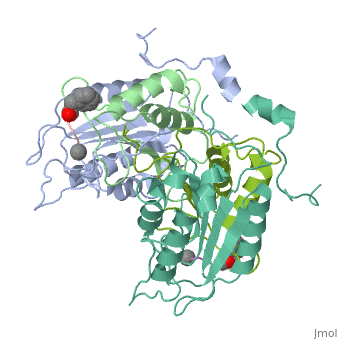Human Caspase-1
|
IntroductionIntroduction
Caspases (cysteine-aspartic proteases) are proteolytic enzymes that play essential roles in apoptosis, development, inflammation, and the immune system. As the name suggests, caspases cleave proteins on the C-side of aspartic acid residues. As of now, around 15 caspases have been identified in two categories, inflammatory (which caspase-1 is classified as) and apoptotic. Apoptotic caspases are further divided into initiator (apical) caspases and effector (executioner) caspases. Initiator caspases cleave and activate effector caspases, which in turn start apoptosis by cleaving other proteins in a cascade reaction. Faulty or premature apoptosis is a main component of autoimmune diseases, leading to research into caspase inhibitors to treat diseases like Alzheimer's. Inflammatory caspases on the other hand usually work by proteolytically actiavting cytokines, leading to a different kind of cell mediated death called pyroptosis.
Activation and RegulationActivation and Regulation
Caspase-1 begins as a proenzyme which is cleaved into 20kDa and 10kDa subunits. ASC and Ipaf have been identified as possible regulators of caspase-1 in a structure called the inflammasome.[1] ASC leads to ATP-driven activation of caspase-1, while Ipaf connects signals triggered by intracellular pathogens. Both of these activators are essentail for caspase-1 driven cell death, showing a link between inflammation and apoptosis. Adaptors in the inflammasome react to extracellular and endogenous danger signals, usually flaggelin, to activate caspase-1 and begin the inflammatory response.
StructureStructure
Caspase-1 consists of four subunits, two 20kDa (alpha) and two 10kDa (beta) pieces, joining to make a homodimer. It has two active sites, which can be linked as is the case with caspase-1. The large alpha subunit contains the proteolytic dyad residues , while the smaller subunit contains residues that form a groove for ligand binding.
FunctionFunction
Caspase-1, also known as ICE (interleukin-1beta converting enzyme) recognizes four residue sequences, requiring an aspartic acid in the P1 position of it's substrates, while P2 - P4 can be ambiguous. It's primary function is to activate the inflammatory cytokines IL1-beta and IL18 by cleaving their precursors.
Caspase-1 also displays cooperative binding through active states, an on-state when ligand is bound and an off state when the active site is vacant or when synthetic ligands are bound at the allosteric site. The allosteric site exists at the dimer interface and is connected to the active sites by a system of 21 hydrogen bonds from 9 residues. Of these 9 residues, only two have a major effect on enzyme activity- Arg286 and Glu390, which form a salt bridge. Although only some of the residues are necessary for activity, the continuous string of interactions connecting the active site to the allosteric site to the second active site make up a kind of circuit leading to cooperative binding. [2]
